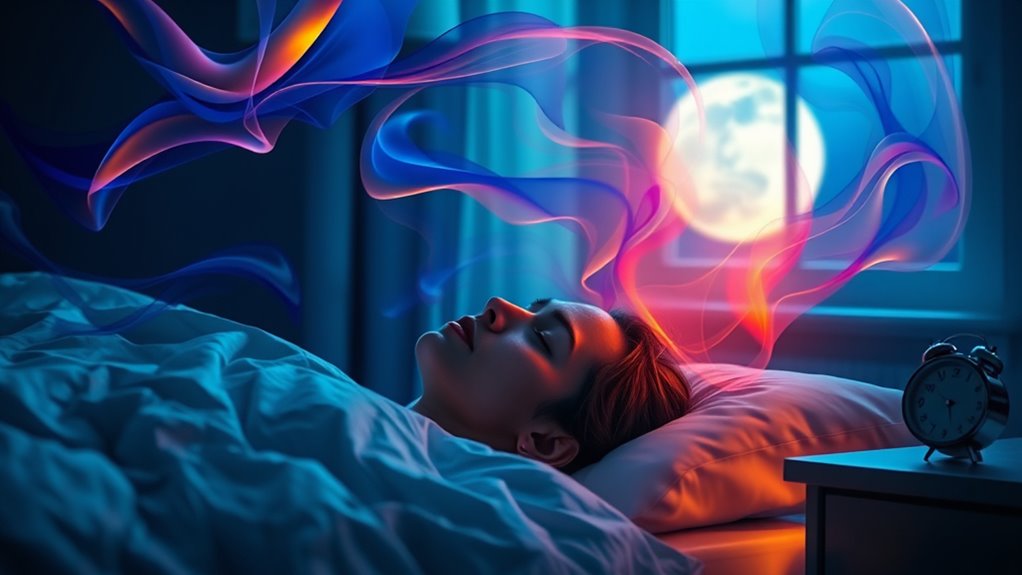Recent research shows that dreaming during REM sleep plays a vital role in emotional processing, memory consolidation, and exploring your subconscious. Dreams help you work through unresolved feelings, rehearse future scenarios, and boost creativity. They also serve as a communication channel from your inner mind, offering insights into personal growth and emotional well-being. If you want to understand more about why this nightly phenomenon happens and what it reveals about you, keep exploring the fascinating science behind dreams.
Key Takeaways
- Recent research suggests REM sleep aids emotional regulation by processing and integrating memories and feelings.
- Dreaming during REM may serve as mental rehearsal, enhancing problem-solving and adaptive behavior.
- Studies indicate REM sleep helps consolidate complex cognitive skills and supports creative thinking.
- New findings highlight REM’s role in maintaining neural plasticity and overall brain health.
- Understanding dream symbolism reveals subconscious insights, promoting emotional healing and personal growth.

Dream symbolism is another key element of REM sleep. Your dreams often contain symbols—images, objects, or scenarios that represent deeper feelings, desires, or fears. For example, dreaming of flying might symbolize freedom or escape, while being chased could indicate anxiety or avoidance. Recognizing these symbols allows you to decode what your subconscious is trying to tell you. Many psychologists believe that understanding dream symbolism can provide insights into unresolved conflicts or unmet needs. As you become more familiar with common dream symbols, you might start noticing patterns, helping you understand your emotional landscape better. Additionally, some research suggests that dream analysis can facilitate emotional healing and personal growth by uncovering hidden messages from your subconscious.
The purpose of dreaming, particularly during REM sleep, remains a topic of ongoing research. Some theories suggest that dreams serve as a form of mental housekeeping, helping you process memories and emotions accumulated during the day. Others propose that dreams are a way for your brain to rehearse real-life scenarios, sharpening your problem-solving skills or preparing you for future challenges. Lucid dreaming, in particular, might play a role in enhancing creativity and self-awareness, offering a safe space to explore different facets of your personality. Meanwhile, interpreting dream symbolism can help you uncover hidden aspects of yourself, promoting personal growth.
In essence, your dreams during REM sleep are more than just random images; they’re a complex blend of subconscious messages, emotional processing, and creative exploration. Whether you’re experiencing the clarity of lucid dreaming or deciphering dream symbolism, these nocturnal narratives provide a valuable glimpse into your inner world. By paying attention to them, you may access new understanding and gain a deeper appreciation for what your mind is trying to communicate while you rest.
Frequently Asked Questions
Can Dreaming Occur During Non-Rem Sleep?
Dreaming can occur during non-REM sleep, but it’s less vivid and detailed than REM dreams. During non-REM, dreaming mechanisms produce more fragmentary and less emotional dreams. You might experience fleeting images or sensations, but they lack the clarity of REM sleep dreams. So, yes, non-REM dreams happen, but they’re typically simpler and less memorable, reflecting different brain activity and dreaming mechanisms compared to REM sleep.
How Do Sleep Disorders Affect REM Sleep Cycles?
When you have sleep disorders like sleep apnea or restless legs, your REM sleep cycle takes a hit. These issues disrupt your sleep, causing frequent awakenings and preventing you from reaching deep REM stages. As a result, your dreams may become fragmented, and restorative sleep suffers. You might think you’re burning the candle at both ends, but in reality, your sleep disorders are robbing you of vital REM sleep, impacting overall health.
Is There a Link Between Dreaming and Memory Retention?
Yes, there’s a strong link between dreaming and memory retention. When you recall your dreams, you’re engaging in a process that helps with memory consolidation. During REM sleep, your brain processes and stores information from the day, and vivid dreams often reflect this activity. Improving dream recall can enhance your ability to retain new memories, making your overall cognitive function sharper and more efficient.
How Does Age Influence REM Sleep Duration?
As you age, age-related changes impact your REM sleep duration, often leading to a decrease. Sleep maturity develops through childhood and adolescence, with REM sleep peaking and then gradually declining in adulthood. This reduction can affect memory and emotional regulation. Younger individuals typically experience more REM sleep, while older adults notice less, highlighting how age influences your sleep patterns and the importance of adapting sleep habits to support overall health.
Can Dreaming Be Artificially Induced or Controlled?
Did you know that about 55% of people experience at least one lucid dream annually? You can actually induce or control dreams through techniques like dream manipulation, which involves training your mind to recognize when you’re dreaming. Lucid dreaming allows you to be aware and even steer your dreams. While not foolproof, practicing these methods can increase your chances of experiencing conscious control over your dreams.
Conclusion
So, next time you wake up from a vivid dream, remember it might be your brain’s way of processing emotions or memories. Imagine Sarah, who kept dreaming about flying after a stressful week—her dreams helped her feel more in control. These insights show that REM sleep isn’t just about dreaming; it’s essential for mental health. Embrace your dreams—they’re your brain’s way of working through life’s challenges, giving you a fresh start each morning.









